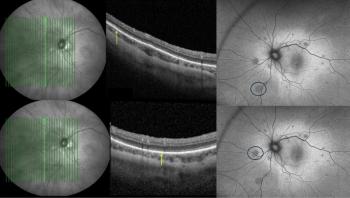
Follow-up injection with intravitreal triamcinolone improves PDT outcomes
Combination treatment of neovascular age-related macular degeneration (AMD) using verteporfin photodynamic therapy (Visudyne PDT, Novartis/QLT Inc.) plus intravitreal triamcinolone acetonide appears to improve visual outcomes and reduce the number of re-treatments necessary to achieve lesion regression compared with standard PDT alone, albeit with the recognized steroid-associated risks of cataract progression and IOP elevation, said Albert J. Augustin, MD, at the annual meeting of the American Society of Retina Specialists.
Combination treatment of neovascular age-related macular degeneration (AMD) using verteporfin photodynamic therapy (Visudyne PDT, Novartis/QLT Inc.) plus intravitreal triamcinolone acetonide appears to improve visual outcomes and reduce the number of re-treatments necessary to achieve lesion regression compared with standard PDT alone, albeit with the recognized steroid-associated risks of cataract progression and IOP elevation, said Albert J. Augustin, MD, at the annual meeting of the American Society of Retina Specialists.
"As a nonrandomized, single centre case series, this study has numerous limitations, and so we look forward to results from prospective trials currently under way evaluating the efficacy, safety, application time and dosing of adjunctive triamcinolone," he commented.
The rationale for the combination treatment is based on knowledge of the pathogenesis of AMD and the response to PDT. Both lifetime chronic light exposure and PDT generate free radicals and result in inflammatory reactions that lead to the expression of a host of growth factors, including vascular endothelial growth factor (VEGF), Augustin explained.
Strategy for CNV regression
"Recognizing that VEGF is expressed secondarily in the cascade of inflammatory events that follows PDT, the best strategy for achieving CNV regression with PDT would appear to follow it with a drug that is anti-inflammatory and has anti-VEGF activity," he said.
The 199 eyes in the series had a mean visual acuity (VA) of 20/125 (range, 20/32 to hand motion) and a mean lesion size of 3425 µm. Lesions of any composition were eligible for treatment, and lesions were subfoveal in 80.4% of the 199 eyes, juxtafoveal in 10.1%, and extrafoveal in 9.5%.
The mean number of treatments necessary for complete regression was 1.32. Compared with the baseline value, VA at last visit for all eyes had improved by a mean of 1.1 lines, and the effect was even more evident when measured with laser interferometry (mean +1.26 lines).
In subgroup analyses, VA improved in all lesion composition groups and in lesions larger and smaller than 2,600 µm. However, at this time of follow-up, the changes compared with baseline were statistically significant only in eyes with subfoveal lesions and lesions >2,600 µm. This also means that the results are not driven by the juxta- and extrafoveal lesions.
Analysis of mean number of lines changed showed nearly 60% of eyes had increased visual acuity (>1 line and up to 7 lines) and >70% showed improvement or real stabilization with loss of less than 1 line. In 20% of eyes, VA decreased by 1 to 3 lines, and only 8% of eyes lost more than 3 lines of VA. A side-to-side comparison of these results to other studies clearly shows that this combination approach leads to a response rate of >90%.
The most common side effects were acceleration of cataractogenesis and IOP elevation. Of eyes that were phakic when first treated, 61% had undergone cataract surgery during the follow-up, and the proportion of eyes with IOP elevation increased over time.
"As of now, transient increase in IOP was observed in 26% of eyes. Almost all of those events could be controlled with topical medications, although 2.6% of eyes required surgery, usually involving a cyclodestructive procedure," Augustin reported.
Newsletter
Get the essential updates shaping the future of pharma manufacturing and compliance—subscribe today to Pharmaceutical Technology and never miss a breakthrough.













































